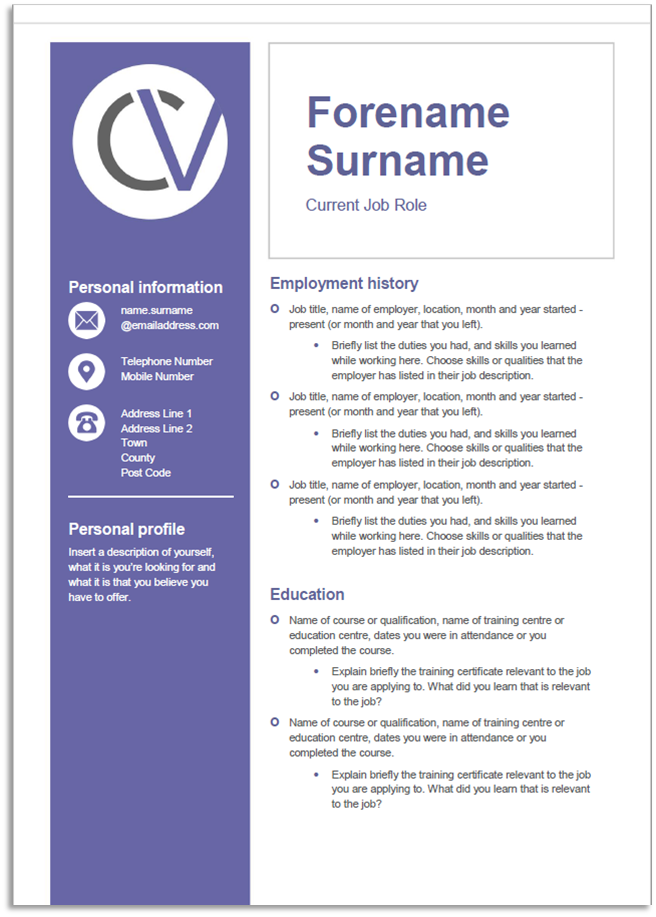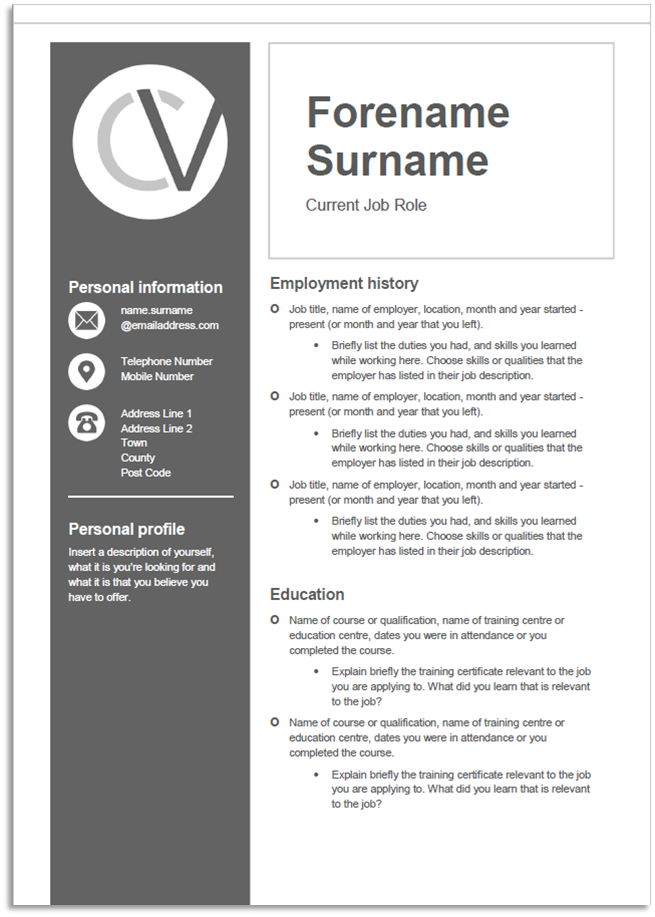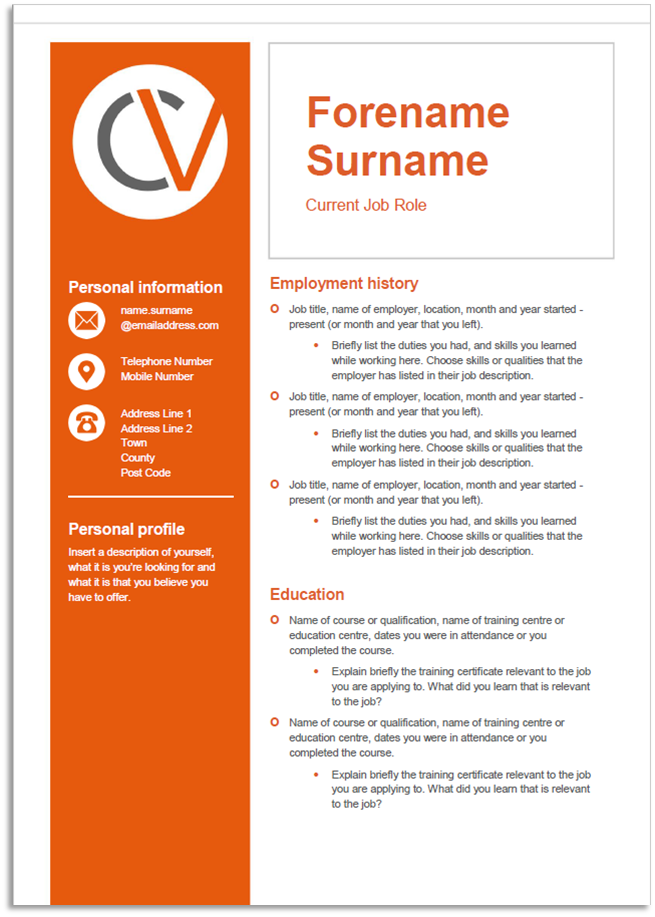Lorry driving is a great career to jump into if you have just left education, been made redundant in another industry, or are looking to try something new.
To land a job as a LGV Driver, your CV will need to show that you’re patient, have great problem solving skills, able to work alone, and of course have the relevant driving licences.
Whether you're looking to start your LGV driving career or looking for your next challenge, our free CV template is tailored to ensure your CV stands out from the crowd.
A guide to writing a CV for a LGV Driver job
Name: Tom Gallagher
Tel No: 0000 0000 00
Email: TomGallagher@email.com
Address: 77 Harehills Lane
Roxby
TS13 1BW
Personal Profile
In the personal profile, you should professionally introduce yourself, in three or four sentences, with relation to the job you’re applying to. Include: your current work situation, what type of work you are searching for (such as part-time, flexible hours, or full-time employment starting immediately) some key skills and/or traits that will show the potential employer that you are a good candidate for the advertised job.
If you are a fully qualified LGV Driver with several years experience and have a good knowledge of major highways, mention this here.
If you don’t have your lorry driving licence, that’s okay. Just write that you are looking for your first role that will provide you with training. You could highlight that you have a car driving licence in this section too.
EXAMPLE:
I am a hard-working and reliable class 2 qualified LGV driver. I am looking for a challenging full-time role that will improve my driving skills.
Work History
The work history section is to show the potential employer what jobs or work experience you’ve done. You don’t need to include every last detail about your duties or achievements for each job. Include only skills and duties that are relevant to the job you're applying for, as you want to show that you are a good fit for the job. If you find you have lots to write about, you can always write down and save your examples or other relevant skills for the interview.
- Job title, name of employer, location, month and year started – present (or month and year that you left)
- Briefly list the duties you had, and skills you learned while working here. Choose skills or qualities that the employer has listed in their job description
EXAMPLE:
- Class 2 LGV driver, Prestons of Potto, North Yorkshire, June 2017 – present
- Responsible for maintaining my lorry, working with two other drivers on the same route, completing delivery paperwork, recording mileage, and assisting with loading and unloading goods
- I have learned how to effectively plan my route, look after my vehicle, adhere to current safety requirements, and have a good knowledge of the local area and road network
What jobs should you include?
- Try to include your work history for the last five years. If you haven’t been working for that long, that is okay. It will be explained by the education history. If you have recently moved to the country, it’s okay to include employment in other countries.
- If you’re applying for your first role in this sector, it’s still important to include your work history. Use it to highlight relevant skills that the employer is looking for, such as organisation, team work and good communication.
- Include details of any jobs that have involved driving, even if it’s a small van or a car – this still shows you are responsible and a driver than a potential employer can trust.
Education History
In education history, this is a chance to show any relevant training you have done, what skills you have learned from your courses, as well as general education subjects you’ve done. As you get more work experience, this section will become shorter, as your work history becomes more relevant and more recent.
To be an LGV Driver you need to have the correct licences. There are 4 types of licences;
• LGV Cat C1 (aka 7.5tonne)
• LGV C1E (aka 7.5 tonne with trailer)
• LGV Cat C (aka HGV Class 2)
• LGV Cat C+E (aka “HGV Class 1”)
If you don't have one, you can find out more about the different types of commercial driving licences available.
- Name of course or qualification, name of training centre or education centre, dates you were in attendance or you completed the course
- Explain briefly the training certificate relevant to the job you are applying to. What did you learn that is relevant to the job?
EXAMPLE:
- Class 2 Driver CPC course, Yorkshire Driver Training, May 2017
- Covered hazard perception, record keeping, safe loading of goods, road safety and laws, fuel efficiency, risk assessments, incident reporting, and practical lorry driving
- CPC driver card: Expires 2022
If you have completed courses or gained certificates such as first aid, include that information here, as well as details of your car driving licence.
Skills
Here is your chance to highlight the best skills you have in relation to the job you’re applying for. Hint: these will be the skills listed in the job advert, but only highlight the skills you have. Misleading information on your CV is likely to trip you up in an interview and is unprofessional; you don’t have to show you have every last skill listed in the job advert to be successful.
EXAMPLE:
- Driving and concentration – ‘From longer routes I have improved my practical lorry maneuvers and ability to stay focused on the road for long periods of time. I always take the most direct and safest route.’
- Communication and team skills – ‘From liaising with customers about deliveries, and my manager, I have improved my listening and communication skills. I can now easily discuss problems with colleagues and customers, and work as a team towards finding a solution.’
References
First and last name
Job title and relation to you in the work place (if it isn’t obvious from the job title), name of work place, work contact number (or main company phone number which they can be reached through) and work email address
EXAMPLE:
Alex Smith
Manager,
Prestons of Potto, North Yorkshire
0000 0000 00
alexsmith@email.com
Who should you include as a reference?
- Your first reference should ideally be from your current or most recent manager. The second reference can be from a current colleague, or line manager or supervisor from a previous job. It’s best practice to ask someone if they will be a reference for you before they are contacted. Be aware that not all employers actually contact references, but it’s important to have them available if needed.
- It’s important to remember that while you are in your current job, consider that you may not want your reference (eg. your current head chef/boss) to be contacted until you have had an interview for a new possible job, or are actually offered it. This is because, for instance, if you weren’t offered the new job, and end up staying in your current job then you might not want your manager having been contacted as a reference. It can cause tension or awkward conversations about why you were trying to leave. A good way to get around this is to simply write ‘References available on request’. This shows the new employer that they can ask you for them as needed, but also means you can ask them to only contact them if you are offered the job, and then have time to ask the reference if it’s okay for them to be contacted. Most potential employers will be happy to wait to do this after offering you the job.
- If you have only had one previous job, or have been studying, it is okay to include a tutor as a reference, or someone else as a character reference (who is not related to you).






